

Tuesday, September 3, 2002
![]()
Carnival Cruise Ship
 We
woke today with the tide even higher than it was the day before. Everything
was flooded. The sun was shinning and it was quite beautiful.
We
woke today with the tide even higher than it was the day before. Everything
was flooded. The sun was shinning and it was quite beautiful.
We knew it was Tuesday just by looking at the horizon. The Carnival cruise
ship was back with a new tour group and anchored off the coast of Belize
City. During the season, the ship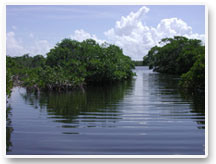
always appears on Tuesday and leaves on Wednesday. It is huge! We mused
about what a different experience we were having from those on the cruise
ship. If nothing else, we can safely bet that they are probably cleaner
than we are. Team member “X”, whose name shall not be mentioned
but who has to do her math homework each night, is on her sixth day without
a shower. She is trying for a record. The rest of us may just have to force
her into the shower if it gets much worse! Then again, she is swimming in
the ocean for several hours each day.
After breakfast the team was again divided into two groups. One team stayed
back to process yesterday’s seagrass samples and the other went out
in the boat to look for manatees.
Manatee Sightings
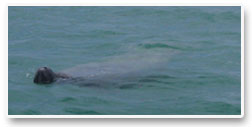 Today
was a bonanza—we saw eight manatees! One was a mother and a juvenile.
The mother took a number of paddle dives
Today
was a bonanza—we saw eight manatees! One was a mother and a juvenile.
The mother took a number of paddle dives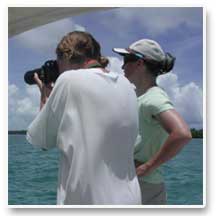 very
near us. From the boat it looked like she had some scarring on her back.
We spent quite a bit of time trying to get a good photograph of her paddle
and scars so that Caryn might match her to one of the animals she has catalogued.
very
near us. From the boat it looked like she had some scarring on her back.
We spent quite a bit of time trying to get a good photograph of her paddle
and scars so that Caryn might match her to one of the animals she has catalogued.
While props can be very damaging to manatees, encounters with the hulls
of boats can also be potentially harmful and even fatal to manatees. A collision
with a moving boat or ship can cause damage to a manatee’s internal
organs, internal bleeding, or a head injury. A manatee’s lungs run
almost the entire length of its body and are located right underneath the
skeleton near the top of the animal. A bruised or punctured lung can lead
to pneumonia and the animal’s eventual death.
At one point it started raining and we all huddled in the center of the
boat for cover. It didn’t do much good though as the wind was blowing
the rain through the boat. Tami finally jumped in the water to get warm.
Waiting for the rain to stop we spent some time investigating the nearby
mangrove trees. There were mangrove oysters growing on some of the roots.
Underneath a dead fish was floating nearby.
Needle In A Haystack
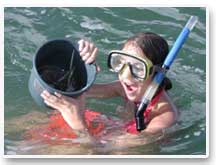 Katie
is attempting to measure the growth rate of turtlegrass—a particular
type of seagrass that manatees eat. The first day we were here we anchored
at the mouth of Bogue G. Katie marked 20 plants growing on the bottom of
the sea floor by placing a plastic tie with an orange streamer at the base
of each of the 20 plants. She then took a safety pin and put a hole in one
of the leaves at the base of each plant.
Katie
is attempting to measure the growth rate of turtlegrass—a particular
type of seagrass that manatees eat. The first day we were here we anchored
at the mouth of Bogue G. Katie marked 20 plants growing on the bottom of
the sea floor by placing a plastic tie with an orange streamer at the base
of each of the 20 plants. She then took a safety pin and put a hole in one
of the leaves at the base of each plant.
The plan was to return today and pull up all 20 plants. By looking at where
the original hole was in the leaf in relation to the plastic tie she can
measure how much the plant has grown. There was nothing on board that first
day to mark the location of the sample site so she used the boat’s
broom, sticking its handle deep in the mud. We of course took a waypoint
(remember waypoints map to degrees longitude and latitude) and Gilroy took
a visual marker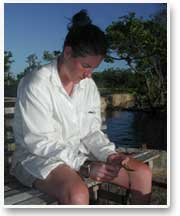 on the shoreline.
on the shoreline.
We stopped at the location that Gilroy thought contained the broom and samples.
Confident that they were directly beside the boat he dove down only to discover
that they were nowhere in sight. As he searched around a bit, it slowly
dawned on us that we could be there a very long time. Where in all this
water could they be? A search party jumped overboard to help. After an hour
and a half of searching Gilroy found the broom. He is truely an amazing
diver. All but three plants were retrieved! Katie was happily measuring
plant growth in the late afternoon.
After the boat returned, some people went snorkeling down the shore from
our research station. A large chunk of the seabed had collapsed at some
point leaving a long channel and a 20-foot “hole”. This area has
a lot of interesting sea life. The snorkelers saw an eight-inch long hermit
crab, a ten-inch diameter clamshell, sea cucumbers, and clusters of coral
with brightly colored fish of all types swimming through them. Caryn saw
a Jew fish—a huge grouper-like fish three to four feet long with a
giant mouth. Despite its size, it is thought to be harmless, but looks somewhat
intimidating.
The Feast
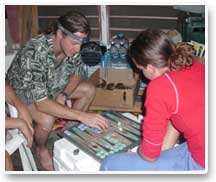 The
task tonight was to cook all the remaining food because tomorrow we restock
with fresh supplies. Ernest, Pam, and Mike made lobster curry, fried rice,
plantains, cabbage-potato stew and a potato frittata. Delicious! After dinner
there was a backgammon game.
The
task tonight was to cook all the remaining food because tomorrow we restock
with fresh supplies. Ernest, Pam, and Mike made lobster curry, fried rice,
plantains, cabbage-potato stew and a potato frittata. Delicious! After dinner
there was a backgammon game.
Tomorrow Pam, Ernest, and Katie leave for home. We will all take the boat
to Belize City. Hannah and Tami will shop for next week’s supplies.
Those that are leaving will head for the airport while the rest of us will
probably try and eat everything we have been craving for this past week.
We will also be visiting the zoo. Apparently the zoo in Belize City is an
educational center and quite good. At 4:00 PM we will all meet back at the
dock along with Steve and Jen who flew into the country today and will be
joining us for the remainder of the trip.
![]()